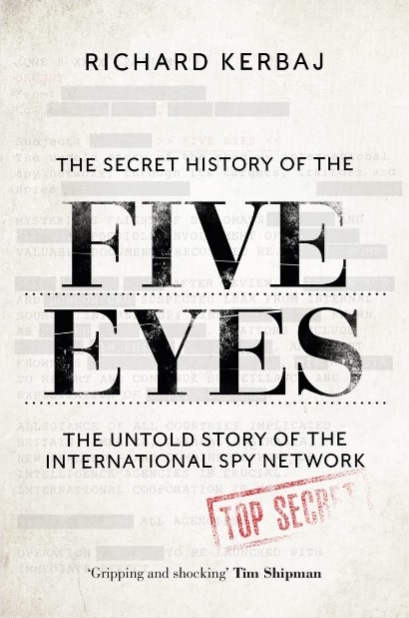ISBN 978-1789465037, Union Square & Co., 2025, 448 pages, $29.99 (hardcover)
Reviewed by: Dr. David P. Oakley, University of South Florida—Global and National Security Institute, Tampa, Florida, USA
Richard Kerbaj’s The Secret History of the Five Eyes: The Untold Story of the International Spy Network is a captivating read that is a valuable contribution to the literature on the Five Eyes partnership. The book considers the evolution of the intelligence relationship among the United Kingdom, United States, Canada, Australia, and New Zealand (“the Five Eyes”). Although focused on the partnership, Kerbaj uses historical events and personal stories, both known and unknown, to take the reader on an entertaining journey through the ebb and flow of the relationship. Beyond the fascinating historical accounts, he interviewed over one hundred politicians, practitioners, and academics to get a broad perspective on the Five Eyes partnership. Kerbaj, a renowned journalist and BAFTA award-winning documentarian, interviewed numerous former senior leaders, including two British prime ministers and two Australian prime ministers. This impressive access enables him to provide first-hand perspectives from those who not only experienced the relationship but led their states through the highs and lows of the partnership.
The book’s main theme is that the Five Eyes partnership did not evolve through a deliberate plan but is the result of each member pursuing its own interest while finding common cause based on the shared threats they faced. This relationship has its challenges, as the various rocky patches that Kerbaj describes highlight, but the Five Eyes partnership has not merely survived these periods—it has strengthened due to them.
The book is broken into four historical periods: Origins, The Cold War, The War on Terror, and Unconventional Battlefields. The Origins section begins before the well-known UK and U.S. signals partnership that originated during the Second World War. It begins with the story of Jessie Jordan, a beautician and Scottish expatriate, who returns to her native home and begins spying for the Third Reich after 30 years in Germany. Through Jess, Kerbaj introduces several characters to weave the story of how intelligence collaboration between the UK and the U.S. started prior to the Britain–United States of America Agreement (BRUSA). With this foundation, Kerbaj then explains how the relationship evolved based on the necessity of war and the interests of the countries involved.
The remaining three sections take a similar approach to the Origins section by providing stories that establish strategic context and explain how and why the relationship evolved. Importantly, Kerbaj does not focus merely on success stories and kumbaya tales. Instead, his selected accounts provide the reader with an appreciation of how relationships shift both between individual countries and within the group as a whole. His approach captures both the tension and value in the relationships, while also highlighting that the partnership takes nurturing and sacrifice from all states involved.
As with any research on intelligence partnerships, The Secret History of the Five Eyes does not capture all the bureaucratic details of how the alliance evolved or the operations that occurred. This is less a critique than an acknowledgment that telling the story of secret partnerships is always incomplete and therefore a developing story. Kerbaj’s contribution is that, through masterful storytelling, he increases all our knowledge of the relationship while presenting the foundational elements in an engaging way that allows for further development. Along the way, he uncovers secrets that might never have been known without his research efforts. Each one is a valuable contribution to our shared understanding.
Although the existence of the Five Eyes partnership is well known, there is scarce scholarship focused solely on the topic. This is unfortunate given the current political climate and the significant changes being brought about through policy and rhetoric. In this environment, we all need a better appreciation of a relationship that has existed for over eight decades and helped transition us through a world war, a Cold War, and a war on terrorism. Richard Kerbaj’s The Secret History of the Five Eyes helps fill this gap in an enjoyable way that provides the reader with a better understanding of the evolution of the relationship.
I recommend this book for readers who want to understand the evolution of this important alliance or anyone who enjoys a gripping story. Hopefully, Kerbaj, who is also a successful filmmaker, will turn his book into a documentary or mini-series to reach a broader audience. We would all benefit from knowing more about this important partnership and would enjoy being engrossed in his masterful storytelling as we do. If you like to both learn and be entertained, I highly recommend The Secret History of the Five Eyes. You won’t be disappointed.
David P. Oakley is the Academic Director at the University of South Florida’s Global and National Security Institute. He has over 22 years of experience in the U.S. Army and Intelligence Community. A former CIA Staff Operations Officer and Army strategist, he has held key roles in Iraq, the National Counterterrorism Center, and various defense planning assignments. He holds a Ph.D. in Security Studies from Kansas State University, an MPA from the University of Oklahoma, and multiple master’s degrees in military studies.








